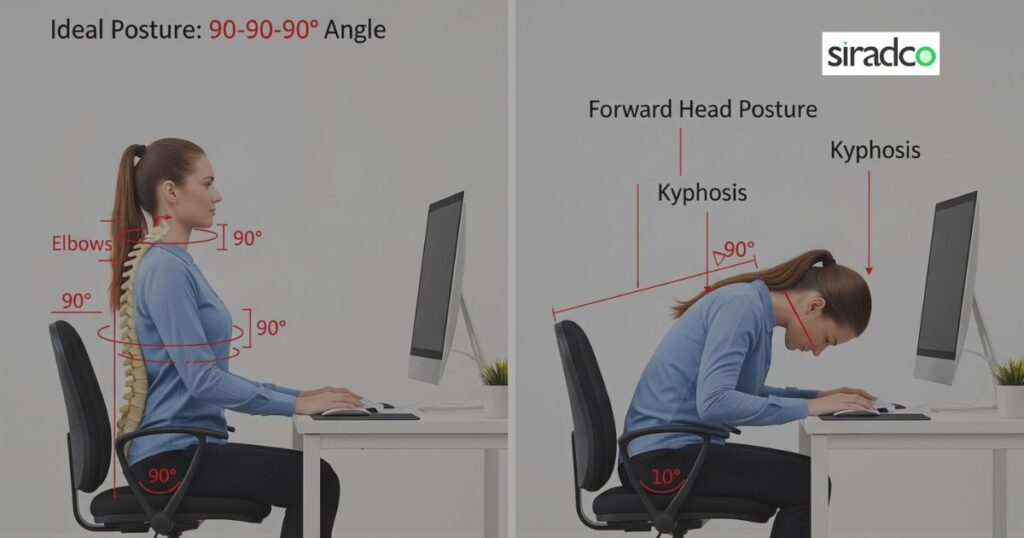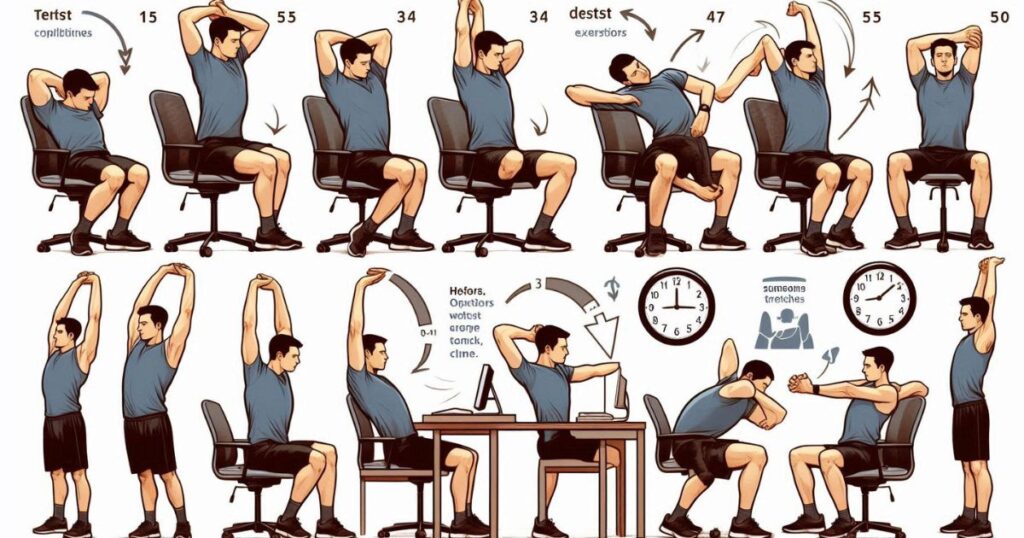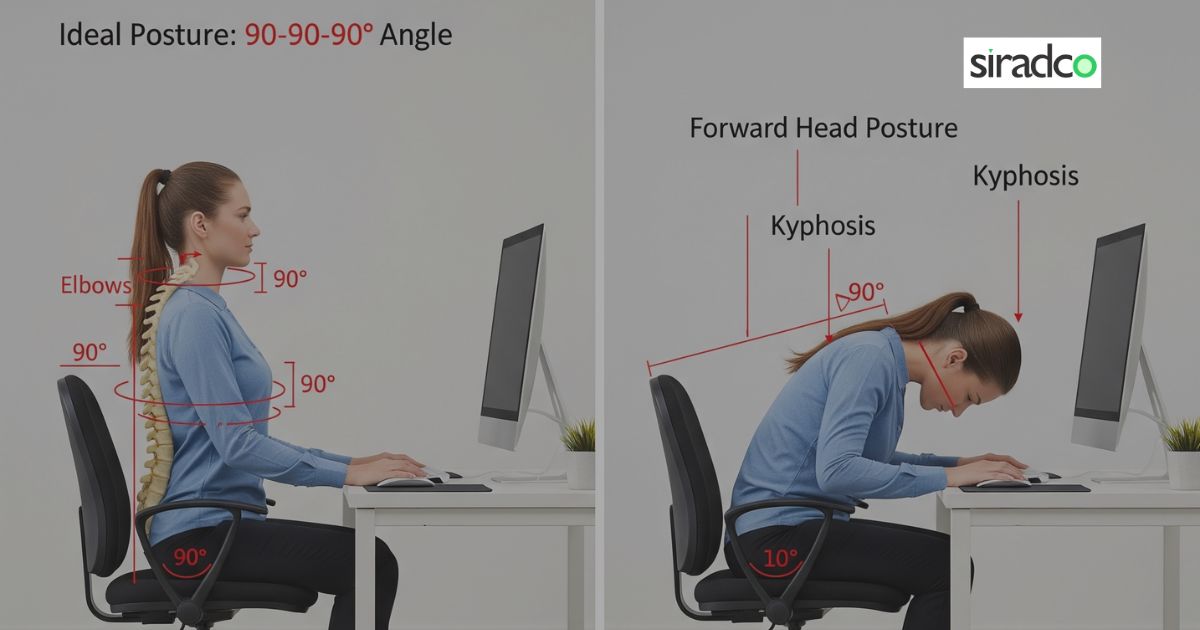Introduction
Neck pain affects millions of workers who spend hours hunched over computers daily. This discomfort becomes a constant companion for remote employees and office workers alike.
The modern workplace demands long hours of screen time. Your neck bears the burden of poor posture and repetitive strain. This creates a cycle of tension that radiates through your shoulders and upper back.
Do you feel that familiar ache creeping up your neck after a long workday? You’re not alone in this struggle. Many people experience sore necks and shoulders from their computer setup.
This article explores the root causes of computer-related neck pain. We’ll cover practical prevention strategies and effective treatment options. You’ll discover how to protect your neck health while maintaining productivity.
What Causes Neck Pain from Computer Work?
Poor Posture
Your posture directly impacts your neck health during computer work. Slouching forward places excessive strain on your cervical spine. This position forces your neck muscles to work harder than they should.

When you lean toward your screen, your head moves forward. This creates an imbalance that your neck muscles must compensate for. The average human head weighs about 10-12 pounds.
Forward head posture can increase this effective weight to 40-60 pounds. Your neck muscles weren’t designed to support this load. This leads to muscle fatigue and eventual pain.
The natural curve of your neck flattens when you slouch. This positioning compresses your vertebrae and increases pressure on your discs. Your muscles become overworked trying to maintain this unnatural position.
Prolonged Screen Time
Extended periods of staring at your computer screen create multiple problems. Your neck muscles remain in a static position for hours. This lack of movement reduces blood flow to the area.
When you focus intensely on your screen, you tend to hold your breath. This creates additional tension in your neck and shoulder muscles. Your body becomes rigid as you concentrate on your work.
Eye strain from screen work often causes you to crane your neck forward. You unconsciously move closer to see better. This compounds the postural problems already present.
The blue light from screens can also contribute to muscle tension. Your eyes work harder to focus, creating a chain reaction of strain. This tension travels up through your neck and into your shoulders.
Lack of Movement
Staying in one position for extended periods creates muscle stiffness. Your neck muscles become shortened and tight from constant contraction. This leads to reduced flexibility and increased pain.
Blood circulation decreases when you remain stationary for too long. Your muscles need fresh oxygen and nutrients to function properly. Poor circulation leads to muscle fatigue and soreness.
Your lymphatic system also relies on movement to function effectively. When you don’t move, waste products build up in your tissues. This creates inflammation and contributes to pain.
Movement helps maintain the natural pumping action of your muscles. This action keeps your joints lubricated and healthy. Without regular movement, your neck joints become stiff and painful.
Ergonomic Factors
Your desk setup plays a crucial role in neck health. An improperly positioned monitor forces you to look up or down. This creates unnatural neck angles that strain your muscles.
Chair height affects your entire posture chain. If your chair is too low, you’ll hunch forward. If it’s too high, you’ll crane your neck to see your screen properly.
Keyboard and mouse placement also impact your neck position. If they’re too far away, you’ll reach forward. This creates the same forward head posture that causes pain.
The distance between you and your screen matters significantly. Sitting too close or too far away changes your neck angle. This creates compensatory movements that strain your muscles.
The Connection Between Neck Pain and Shoulder Discomfort
Sore Neck and Shoulders
Your neck and shoulders work as an integrated unit. When one area becomes tense, it affects the other. This creates a pattern of pain that spreads across your upper body.
The muscles connecting your neck to your shoulders become overworked. They try to compensate for poor posture and muscle imbalances. This leads to widespread soreness and stiffness.
Trigger points often develop in these connecting muscles. These are tight knots that refer pain to other areas. A trigger point in your neck can cause shoulder pain and vice versa.
The fascia, or connective tissue, also links these areas together. When fascial restrictions develop, they create pulling patterns. This can cause pain to spread from your neck into your shoulders.
Pain in the Neck and Shoulder
The junction between your neck and shoulder is particularly vulnerable. This area contains multiple muscle groups that overlap. When these muscles become tight, they create complex pain patterns.
Your trapezius muscle is often the primary culprit. This large muscle extends from your skull to your mid-back. When it becomes tight, it creates pain throughout the neck and shoulder region.
The levator scapulae muscle is another common source of pain. This muscle lifts your shoulder blade and side-bends your neck. Computer work often overworks this muscle, leading to pain.
Your scalene muscles on the sides of your neck also contribute. These muscles help with breathing and neck movement. When they become tight, they create pain in the neck and shoulder area.
Neck Muscles Hurt
The muscles around your neck work constantly to support your head. Computer work places these muscles under continuous strain. This leads to overuse injuries and chronic pain.
Your cervical erector spinae muscles run along the back of your neck. They work to keep your head upright against gravity. Poor posture makes these muscles work even harder.
The suboccipital muscles at the base of your skull become particularly tight. These small muscles control fine head movements. Computer work often overworks these delicate muscles.
Your sternocleidomastoid muscles on the front of your neck also suffer. These muscles help turn and tilt your head. Forward head posture places them in a shortened position.
Common Types of Neck Pain from Computer Use
Painful Back Neck
The back of your neck bears the brunt of computer-related strain. This area contains the muscles responsible for holding your head upright. When these muscles become overworked, they create significant pain.
Forward head posture particularly affects the back and neck muscles. These muscles must work harder to prevent your head from falling forward. This constant tension leads to muscle fatigue and pain.
The cervical facet joints at the back of your neck also suffer. These joints help your neck move in different directions. Poor posture compresses these joints, causing pain and stiffness.
Muscle tension in the back and neck area often feels like a constant ache. This pain may worsen with movement or prolonged sitting. It can also radiate into your shoulders and upper back.
Back Neck Hurts
When your back neck hurts, it’s often due to muscle strain. The muscles in this area work continuously to support your head. Computer work places excessive demands on these muscles.
The pain typically starts as a dull ache. It may progress to sharp, stabbing sensations with movement. This pain often worsens throughout the workday.
Muscle spasms can also occur in the back and neck area. These involuntary contractions create intense pain and limited movement. They often happen when muscles become severely fatigued.
The pain may also stem from compressed nerves. When muscles become tight, they can press on nearby nerves. This creates pain that may radiate into your arms or hands.
Back of the Neck Pain
Pain at the back of your neck often indicates muscle overuse. The muscles in this area work to extend your neck backward. Computer work often requires these muscles to work overtime.
This pain typically feels like a deep, constant ache. It may worsen when you try to look up or turn your head. The pain often extends into your shoulders and upper back.
Tension headaches commonly accompany back of the neck pain. The muscles at the base of your skull become tight and painful. This creates referred pain that travels into your head.
The pain may also involve your upper trapezius muscle. This muscle connects your neck to your shoulder blade. When it becomes tight, it creates pain across the back of your neck.
Back Neck Ache
A persistent ache in the back of your neck signals muscle fatigue. Your muscles are working harder than they should to maintain your head position. This creates a constant, nagging discomfort.
The ache often starts mild and gradually increases throughout the day. It may feel like a heavy weight pressing on your neck. This sensation comes from overworked, tight muscles.
The ache may also pulse or throb with your heartbeat. This indicates increased blood flow to the area. Your body is trying to supply more oxygen to the working muscles.
Rest and movement changes can temporarily relieve the ache. The pain often returns when you resume your computer work. This cycle indicates that your work setup needs adjustment.
Back Neck Sore
Soreness in the back of your neck indicates muscle overexertion. Your muscles have worked beyond their normal capacity. This creates microscopic damage that results in soreness.
The soreness often feels tender to touch. You may notice increased sensitivity in the affected area. This tenderness indicates inflammation in the muscle tissue.
The soreness may worsen with certain movements. Turning your head or looking up may increase the discomfort. This pain pattern helps identify which muscles are affected.
Morning stiffness often accompanies back neck soreness. Your muscles tighten up during sleep from the day’s overuse. This creates increased soreness when you wake up.
How to Prevent Neck Pain from Computer Work
Take Frequent Breaks
Regular breaks are essential for preventing neck pain from computer work. Your muscles need time to relax and reset. Standing up every 30-60 minutes can prevent muscle fatigue.
During your breaks, focus on moving your neck and shoulders. Gentle stretches help release accumulated tension. Even a few minutes of movement can make a significant difference.
Walking around during breaks increases blood flow to your muscles. This brings fresh oxygen and nutrients while removing waste products. Your muscles function better with improved circulation.
Set reminders to take breaks if you tend to get absorbed in work. Many apps and devices can prompt you to move regularly. Consistency is key to preventing pain from developing.
Adjust Your Workspace
Your monitor should be positioned at eye level or slightly below. This prevents you from looking up or down at your screen. Your neck should remain in a neutral position while working.

Place your monitor about arm’s length away from your eyes. This distance reduces the need to crane your neck forward. You should be able to see the screen clearly without straining.
Your keyboard and mouse should be at elbow height. This prevents you from reaching up or down to use them. Your shoulders should remain relaxed while typing.
Consider using a document holder if you frequently reference papers. Place it at the same height as your screen. This prevents constant neck movement between documents and the screen.
Mind Your Posture
Maintain a neutral spine position while sitting at your computer. Your ears should be over your shoulders, not forward. This alignment reduces strain on your neck muscles.
Keep your feet flat on the floor or on a footrest. This helps maintain proper spine alignment. Your knees should be at about a 90-degree angle.
Your shoulders should be relaxed and not hunched upward. Let them fall naturally to their resting position. Tense shoulders contribute to neck pain and stiffness.
Check your posture regularly throughout the day. It’s easy to slip into poor positions without realizing it. Make corrections as soon as you notice postural problems.
Eye Care
Position your screen to minimize glare and reflections. Bright lights behind or beside your screen cause eye strain. This leads to squinting and forward head posture.
Adjust your screen brightness to match your surroundings. Too bright or too dim can cause eye strain. Your eyes shouldn’t have to work harder than necessary.
Use the 20-20-20 rule to rest your eyes regularly. Every 20 minutes, look at something 20 feet away for 20 seconds. This helps relax your eye muscles and reduce strain.
Consider using blue light filtering glasses or screen filters. These can reduce eye strain from prolonged screen use. Less eye strain means less tendency to crane your neck forward.
Treatment Options for Neck Pain from Computer Work
Physical Therapy
A physical therapist can assess your specific movement patterns and muscle imbalances. They create customized treatment plans to address your particular needs. This targeted approach often provides better results than general exercises.
Physical therapy includes hands-on techniques to release muscle tension. Manual therapy can help restore normal muscle function. This often provides immediate relief from pain and stiffness.
Your therapist will teach you specific exercises to strengthen weak muscles. They’ll also show you how to stretch tight areas properly. This combination helps prevent future pain episodes.
Education about proper posture and movement is a key component. Your therapist will help you understand how to protect your neck. This knowledge empowers you to make better choices throughout your workday.
Posture Correction
Learning proper posture techniques can significantly reduce neck pain. Focus on keeping your head balanced over your shoulders. This position minimizes strain on your neck muscles.
Practice the chin tuck exercise to improve your head position. Gently pull your chin back while lengthening the back of your neck. This helps counteract forward head posture.
Strengthen your deep neck flexor muscles with specific exercises. These muscles help maintain proper head position. Stronger deep neck flexors reduce the workload on your surface muscles.
Use postural reminders throughout your day. Sticky notes on your computer or phone alarms can prompt posture checks. Consistent awareness helps create lasting changes.
Ergonomic Adjustments
Invest in an adjustable chair that supports your natural spine curves. Your chair should allow you to maintain good posture comfortably. Proper lumbar support is particularly important.
Consider using a laptop stand if you work on a laptop. This brings your screen to eye level while allowing external keyboard use. This setup prevents the hunched position laptops typically create.
An ergonomic keyboard and mouse can reduce strain on your arms and neck. These tools help maintain neutral wrist and arm positions. This reduces the overall tension in your upper body.
Standing desks or desk converters allow you to alternate between sitting and standing. This variation reduces the strain of prolonged sitting. Even short periods of standing can provide relief.
Stretching Exercises
Gentle neck stretches can provide immediate relief from tension. Hold each stretch for 30 seconds without forcing the movement. Consistency is more important than intensity.
The upper trap stretch helps release tension in your neck and shoulders. Gently tilt your head to one side while depressing the opposite shoulder. You should feel a stretch along the side of your neck.

Chin tucks help strengthen your deep neck muscles while stretching tight areas. Pull your chin back while lengthening the back of your neck. This movement counteracts forward head posture.
Shoulder blade squeezes help strengthen your upper back muscles. Pull your shoulder blades together while keeping your arms at your sides. This helps counteract the forward shoulder position from computer work.
Chiropractic Care
Chiropractic treatment can help restore proper joint movement in your neck. When joints don’t move properly, surrounding muscles become tight and painful. Chiropractic adjustments can help restore normal function.
Your chiropractor will assess your spine alignment and movement patterns. They can identify areas of restriction that contribute to your pain. This comprehensive evaluation helps guide treatment decisions.
Chiropractic care often includes soft tissue therapy along with adjustments. This combination approach addresses both joint and muscle problems. Many people find this comprehensive treatment very effective.
Regular chiropractic maintenance can help prevent future episodes of neck pain. Your chiropractor can monitor your progress and make adjustments as needed. This proactive approach often prevents minor issues from becoming major problems.
When to Seek Medical Help

Persistent Pain
If your neck pain persists despite trying preventive measures, seek medical attention. Pain that lasts more than a few days may indicate a more serious problem. Early intervention often prevents complications.
Pain that worsens over time rather than improving is concerning. Your body should respond positively to appropriate treatment. Worsening pain may indicate an underlying condition that needs medical attention.
If over-the-counter pain medications don’t provide relief, consult a healthcare provider. They can prescribe stronger medications or recommend other treatments. Don’t suffer unnecessarily when help is available.
Keep track of your pain patterns and triggers. This information helps your healthcare provider make an accurate diagnosis. Be prepared to describe when the pain occurs and what makes it better or worse.
Severe Symptoms
Numbness or tingling in your arms or hands requires immediate medical attention. These symptoms may indicate nerve compression or other serious conditions. Don’t ignore these warning signs.
Weakness in your arms or hands is another red flag symptom. This may indicate nerve damage or other neurological problems. Seek medical help immediately if you experience weakness.
Severe headaches that accompany neck pain may indicate serious problems. These could be tension headaches or something more concerning. A healthcare provider can determine the cause and appropriate treatment.
If you experience dizziness or balance problems with your neck pain, seek medical help. These symptoms may indicate involvement of your vestibular system. This requires professional evaluation and treatment.
Conclusion
Neck pain from computer work is a common but preventable problem. Understanding the causes helps you make informed decisions about your work habits. Simple changes to your routine can provide significant relief.
Taking regular breaks and maintaining good posture are your first lines of defense. These habits prevent pain from developing in the first place. Prevention is always easier than treatment.
When pain does occur, multiple treatment options are available. From simple stretches to professional therapy, you have many choices. Don’t let neck pain interfere with your productivity and quality of life.
Bonus: Neck Pain Relief Checklist
• Take a break every 30-60 minutes • Adjust your chair and desk to proper ergonomic heights • Keep your screen at eye level • Perform regular stretching exercises for your neck and shoulders • Practice good posture while sitting • Use proper lighting to reduce eye strain • Stay hydrated to maintain muscle function • Consider ergonomic accessories for your workspace
FAQ Section
How can I tell if my neck pain is caused by computer work?
Look for signs like soreness, tightness, or discomfort in the neck and shoulder area. These symptoms typically occur after long hours of sitting at your computer. Pay attention to whether the pain improves after moving or stretching.
The pain often starts gradually and worsens throughout the workday. It may be accompanied by headaches or shoulder tension. If your pain follows this pattern, computer work is likely the culprit.
Can neck pain from computer work go away on its own?
Yes, in many cases, neck pain from computer work improves with simple adjustments. Taking breaks, stretching, and improving posture often provide relief. Your body has remarkable healing abilities when given the right conditions.
If the pain persists or worsens despite these measures, seek medical attention. Chronic pain may require professional treatment to resolve completely. Don’t wait too long to get help if self-care isn’t working.
How often should I take breaks to prevent neck pain?
Aim to take a break every 30 to 60 minutes from computer work. Stand up, stretch, and walk around to reduce muscle strain. Even short breaks can make a significant difference in preventing pain.
The key is consistency rather than duration. A two-minute break every 30 minutes is better than a long break every few hours. Your muscles need regular relief from sustained positions.
What are some simple stretches I can do to relieve neck pain?
Effective stretches include neck tilts, chin tucks, and shoulder shrugs. Gentle neck rotations can also help release tension. Be sure to do these slowly and without forcing the movement.
The upper trap stretch is particularly helpful for computer workers. Gently tilt your head to one side while depressing the opposite shoulder. Hold for 30 seconds and repeat on the other side.
Is it necessary to see a doctor for neck pain from computer work?
If your neck pain persists despite taking preventive measures, consult a healthcare provider. Pain that doesn’t improve with self-care may need professional treatment. Don’t suffer unnecessarily when help is available.
Seek immediate medical attention if you experience numbness, tingling, or weakness. These symptoms may indicate nerve compression or other serious conditions. Your health and safety should always be the top priority.

